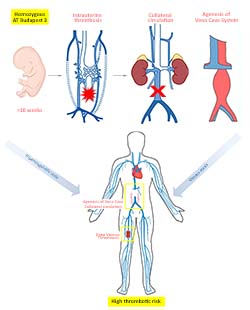
Contributions
Abstract: S303
Type: Oral Presentation
Session title: Dilemmas in coagulation and thrombosis
Background
Agenesis of inferior vena cava (IVC) is a rare congenital malformation with unknown etiology that might be associated with intrauterine IVC thrombosis. The identification of IVC agenesis in a case with early idiopathic venous thrombosis and antithrombin deficiency caused by the homozygous SERPINC1 c.391C>T variant (p.Leu131Phe; antithrombin Budapest 3), encouraged to evaluate the role of severe thrombophilia in this vascular abnormality.
Aims
To study the mechanisms and molecular base of inferior venca cava system.
Methods
Retrospective study of the worldwide largest series of patients homozygous for the Budapest 3 variant (N=60) selected from two cohorts of patients with congenital antithrombin deficiency (Spain, N=638 and Hungary, N=426). Image analysis included computed tomography and phlebography.
Results
IVC system agenesis was observed in 16 out 23 cases homozygous for antithrombin Budapest 3 with available computed tomography (69.6%), fifteen had agenesis of IVC and one atresia of the left iliac vein. All cases with vascular defects had compensatory mechanisms, azygos-hemiazygos continuation or double IVC, and five had other anatomic defects. Short Tandem Repeat analysis supported the specific association of the IVC system agenesis with SERPINC1.

Conclusion
We show the first evidence of the role of a severe thrombophilia in IVC system agenesis. The impaired control of thrombin in carriers might facilitate intrauterine or perinatal thrombosis at this localization. Moreover, the underlying thrombophilia also explains the high risk of thrombosis described in patients with agenesis of IVC. Our results encourage the search for severe thrombophilic states in patients with agenesis of IVC and to consider the use of antithrombotic prophylaxis at risk situations with these vascular defects.
Keyword(s): Antithrombin, Thrombophilia, Thrombosis
Abstract: S303
Type: Oral Presentation
Session title: Dilemmas in coagulation and thrombosis
Background
Agenesis of inferior vena cava (IVC) is a rare congenital malformation with unknown etiology that might be associated with intrauterine IVC thrombosis. The identification of IVC agenesis in a case with early idiopathic venous thrombosis and antithrombin deficiency caused by the homozygous SERPINC1 c.391C>T variant (p.Leu131Phe; antithrombin Budapest 3), encouraged to evaluate the role of severe thrombophilia in this vascular abnormality.
Aims
To study the mechanisms and molecular base of inferior venca cava system.
Methods
Retrospective study of the worldwide largest series of patients homozygous for the Budapest 3 variant (N=60) selected from two cohorts of patients with congenital antithrombin deficiency (Spain, N=638 and Hungary, N=426). Image analysis included computed tomography and phlebography.
Results
IVC system agenesis was observed in 16 out 23 cases homozygous for antithrombin Budapest 3 with available computed tomography (69.6%), fifteen had agenesis of IVC and one atresia of the left iliac vein. All cases with vascular defects had compensatory mechanisms, azygos-hemiazygos continuation or double IVC, and five had other anatomic defects. Short Tandem Repeat analysis supported the specific association of the IVC system agenesis with SERPINC1.

Conclusion
We show the first evidence of the role of a severe thrombophilia in IVC system agenesis. The impaired control of thrombin in carriers might facilitate intrauterine or perinatal thrombosis at this localization. Moreover, the underlying thrombophilia also explains the high risk of thrombosis described in patients with agenesis of IVC. Our results encourage the search for severe thrombophilic states in patients with agenesis of IVC and to consider the use of antithrombotic prophylaxis at risk situations with these vascular defects.
Keyword(s): Antithrombin, Thrombophilia, Thrombosis


